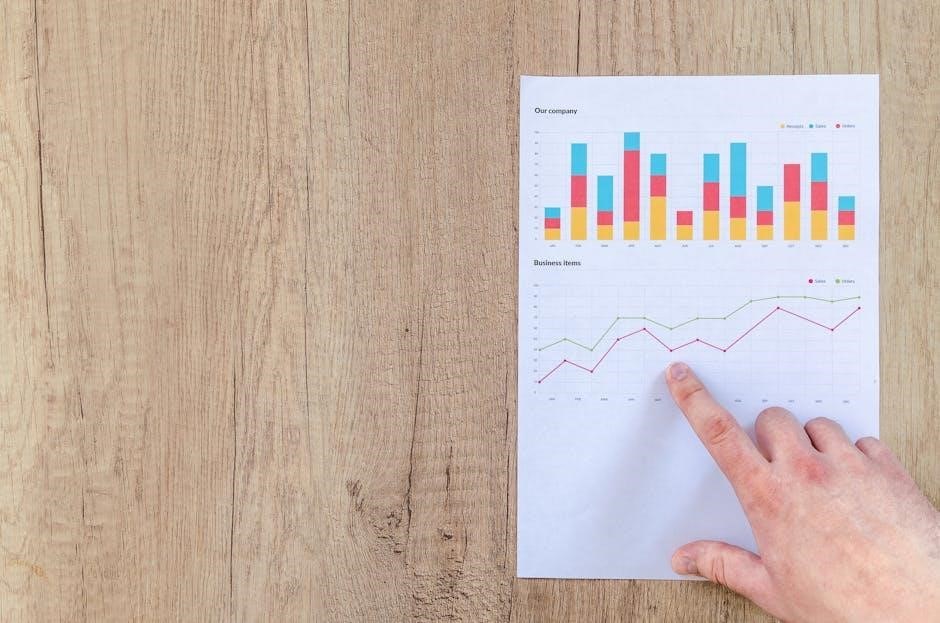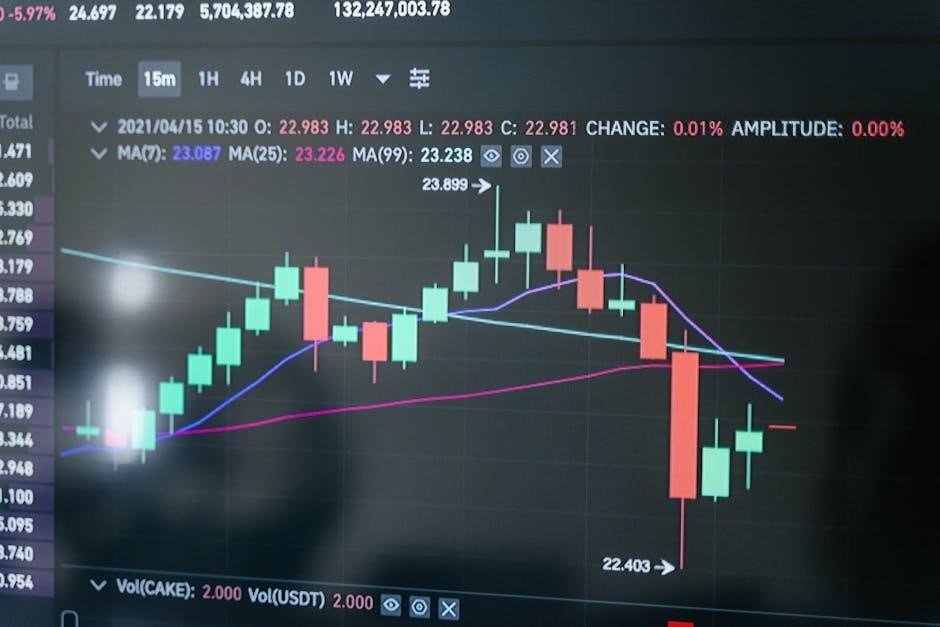Python is a powerful tool for data analysis, offering versatile libraries like Pandas, NumPy, and Matplotlib. Resources like “Python for Data Analysis” by Wes McKinney provide comprehensive guides, while tutorials and books cover essential concepts, making it ideal for beginners and professionals alike.
What is Data Analysis?
Data analysis is the process of extracting insights from data through systematic processing, analysis, and interpretation. It involves cleaning, transforming, and visualizing data to uncover patterns, trends, and meaningful information. Python, with libraries like Pandas and NumPy, simplifies these tasks, enabling efficient data manipulation and analysis. Data analysis is widely applied in fields such as business, science, and finance to support decision-making and problem-solving. By leveraging Python’s robust tools, analysts can handle complex datasets, perform statistical computations, and create visualizations to communicate findings effectively.
Why Use Python for Data Analysis?
Python is preferred for data analysis due to its simplicity, flexibility, and extensive libraries like Pandas, NumPy, and Matplotlib. These tools streamline data manipulation, numerical computing, and visualization, making Python ideal for handling complex datasets. Its large community ensures continuous development and support, with resources like “Python for Data Analysis” by Wes McKinney providing comprehensive guidance. Python’s integration with machine learning libraries such as Scikit-learn further enhances its capabilities, allowing analysts to build predictive models and perform advanced statistical analyses efficiently. This versatility makes Python a go-to language for both beginners and professionals in data science.
Essential Libraries for Data Analysis in Python
Pandas, NumPy, and Matplotlib are core libraries for data manipulation, numerical operations, and visualization, enabling efficient and comprehensive data analysis workflows in Python.
Pandas is a powerful library for data manipulation and analysis in Python. It provides data structures like Series and DataFrames, enabling efficient handling of structured data. With features like filtering, sorting, and merging, Pandas simplifies data processing. It integrates seamlessly with other libraries like NumPy and Matplotlib, making it a cornerstone for data analysis tasks. Whether cleaning data or performing complex operations, Pandas offers robust tools to streamline workflows, making it indispensable for data scientists and analysts working with Python.
Understanding NumPy
NumPy, or Numerical Python, is a library optimized for numerical operations. It introduces multi-dimensional arrays, enabling efficient data storage and manipulation. NumPy arrays are faster and use less memory than traditional Python lists, making them ideal for large datasets. They support vectorized operations, reducing the need for loops and enhancing performance. NumPy is foundational for scientific computing in Python, providing tools for linear algebra, random number generation, and data reshaping. Its integration with libraries like Pandas and Matplotlib makes it essential for data analysis, allowing users to perform complex computations efficiently and effectively.
Exploring Matplotlib and Seaborn
Matplotlib is Python’s premier data visualization library, offering tools to create high-quality 2D and 3D plots. It supports various chart types, such as line plots, bar charts, and histograms, enabling precise data visualization. Seaborn, built on top of Matplotlib, provides a higher-level interface for creating informative and attractive statistical graphics. It simplifies the process of visualizing datasets with advanced features like heatmaps and pairplots. Together, these libraries empower data analysts to communicate insights effectively, making data visualization intuitive and accessible for both exploratory analysis and presentation. Their integration with Pandas ensures seamless visualization of data frames, enhancing the data analysis workflow.

Setting Up Your Environment
Install Python and essential libraries like Pandas, NumPy, and Matplotlib. Use Jupyter Notebook for interactive analysis. Ensure your environment is configured for seamless data analysis workflows.
Installing Python and Necessary Libraries
To begin with data analysis in Python, install the latest version of Python from its official website. Once installed, use pip, Python’s package installer, to add essential libraries like Pandas for data manipulation, NumPy for numerical operations, and Matplotlib for visualization. You can install these libraries using commands such as pip install pandas numpy matplotlib. Additionally, Jupyter Notebook is highly recommended for interactive analysis and can be installed via pip install jupyter. Ensure all installations are successful by running import statements in a Python environment. Refer to resources like Wes McKinney’s “Python for Data Analysis” for detailed guidance on setting up your environment effectively.
Using Jupyter Notebook for Interactive Analysis
Jupyter Notebook is a powerful tool for interactive data analysis, allowing you to write and execute Python code in cells. It provides a web-based interface where you can combine code, visualizations, and narrative text. To use Jupyter, install it via pip install jupyter and launch it with jupyter notebook. This opens a dashboard to create and manage notebooks. Notebooks are ideal for exploratory analysis, enabling incremental testing and visualization of data. They also support rich media, including images and charts from libraries like Matplotlib. Jupyter Notebooks are widely used in data science and education, making them a cornerstone of Python-based data analysis workflows.

The Data Analysis Process
The data analysis process involves importing, cleaning, and transforming data using libraries like Pandas and NumPy, followed by effective analysis and visualization with Matplotlib.
Importing and Understanding Your Data
Importing data is the first step in analysis, typically using libraries like Pandas, which supports formats such as CSV, Excel, and JSON. Understanding your data involves exploring its structure with methods like head, info, and describe. Identifying missing values, data types, and outliers is crucial for preprocessing. Visualization tools like Matplotlib help in understanding distributions and relationships. Resources like “Python for Data Analysis” by Wes McKinney provide detailed guidance on these processes, ensuring a strong foundation for further analysis. Proper data understanding is essential for accurate insights and effective decision-making in any data-driven project.
Cleaning and Preparing Data
Cleaning and preparing data is a critical step in any analysis workflow. This involves handling missing values, removing duplicates, and ensuring data consistency. Python libraries like Pandas offer robust methods for data manipulation, such as dropna for missing data and drop_duplicates for removing redundant entries. Data normalization and standardization are also essential for preparing datasets for analysis or modeling. Using techniques like encoding categorical variables ensures data is in a suitable format for processing. Resources like “Python for Data Analysis” provide detailed insights into these processes, helping analysts create clean, reliable datasets for accurate insights.

Data Manipulation with Pandas
Pandas excels in data manipulation, enabling efficient operations like filtering, sorting, and merging datasets. Key functions such as merge and groupby simplify complex data transformations, making it indispensable for analysts.
Filtering and Sorting Data
Filtering and sorting data are fundamental steps in data analysis, allowing you to focus on relevant information and organize it for better understanding. Pandas provides efficient methods like loc[] and iloc[] for filtering data based on conditions or indices. The sort_values function enables sorting datasets by one or more columns, either in ascending or descending order. These operations are essential for preparing data for analysis, ensuring accuracy, and improving readability. By mastering filtering and sorting, you can streamline your workflow and make data-driven decisions more effectively. These techniques are widely covered in resources like “Python for Data Analysis” and various online tutorials.
Grouping and Aggregating Data
Grouping and aggregating data are essential techniques for summarizing and extracting insights from datasets. In Python, the Pandas library offers powerful tools like groupby to group data by one or more columns and apply aggregation functions such as sum, mean, and count. This allows for efficient analysis of patterns and trends within subsets of data. For instance, you can calculate total sales by region or average scores by category. These operations simplify complex datasets, making it easier to identify key metrics and support decision-making processes. Resources like “Python for Data Analysis” provide detailed guidance on mastering these techniques for real-world applications.
Statistical Analysis in Python
Python is a powerful tool for statistical analysis, leveraging libraries like NumPy, Pandas, and SciPy to perform various statistical tasks efficiently and effectively, enhancing data analysis processes.
Statistical concepts form the foundation of data analysis, enabling the extraction of meaningful insights from datasets. Key ideas include probability distributions, hypothesis testing, and regression analysis. Python libraries like SciPy and Pandas simplify these processes, offering robust tools for calculation and visualization. Understanding these concepts is crucial for making data-driven decisions and validating assumptions. By leveraging Python’s capabilities, analysts can efficiently apply statistical methods to real-world problems, ensuring accurate and reliable results. Mastery of these principles is essential for advancing in data science and conducting sophisticated analyses.
Using SciPy for Advanced Statistics
SciPy extends Python’s capabilities for advanced statistical analysis, offering robust modules for scientific and engineering applications. Its `scipy.stats` module provides comprehensive tools for probability distributions, hypothesis testing, and statistical functions.Users can perform complex analyses, such as regression, correlation, and variance analysis, with ease. SciPy also supports optimization techniques and signal processing, making it a versatile tool for data scientists. By integrating with libraries like Pandas and Matplotlib, SciPy enables seamless data manipulation and visualization, ensuring precise and efficient statistical computations for both academic and professional settings.

Machine Learning for Data Analysis
Machine learning enhances data analysis by enabling predictive modeling and pattern recognition. Libraries like Scikit-learn provide algorithms for classification, regression, and clustering. Integration with Pandas and visualization tools streamlines workflows, making Python a powerful choice for building predictive models and extracting insights from data.
Scikit-learn is a widely-used Python library for machine learning, providing efficient tools for data analysis and modeling. It offers algorithms for classification, regression, clustering, and more, enabling predictive analytics. Designed to integrate seamlessly with libraries like Pandas and NumPy, Scikit-learn simplifies workflows for data preprocessing, feature selection, and model evaluation. Its extensive documentation and community support make it accessible for both beginners and advanced practitioners. Whether building simple linear models or complex pipelines, Scikit-learn empowers data scientists to transform datasets into actionable insights, supported by robust visualization tools for clear communication of results.
Building Predictive Models
Building predictive models involves using historical data to forecast future outcomes. With Python, libraries like Scikit-learn and TensorFlow streamline this process. Models such as linear regression, decision trees, and neural networks are trained on datasets to learn patterns. Techniques like cross-validation ensure model accuracy, while feature engineering enhances data relevance. Hyperparameter tuning further optimizes performance. Tools like Pandas and Matplotlib assist in data preprocessing and visualization, aiding in model evaluation. Predictive modeling applications range from customer behavior analysis to stock market predictions, making it a cornerstone of data-driven decision-making across industries.

Data Visualization Techniques
Data visualization transforms raw data into clear, actionable insights. Python tools like Matplotlib and Seaborn create interactive plots, enabling effective communication of complex datasets. Visualization enhances understanding and decision-making.
Creating Effective Plots with Matplotlib
Matplotlib is a cornerstone library for data visualization in Python, enabling users to create high-quality 2D plots. Its flexibility allows customization of line styles, colors, and labels. Users can generate various plot types such as line charts, bar graphs, histograms, and scatter plots. Matplotlib’s API supports both simple and complex visualizations, making it suitable for academic and professional settings. By leveraging Matplotlib, data analysts can communicate insights effectively, ensuring clarity and precision in their visual representations. This tool is essential for transforming raw data into actionable and understandable visuals.
Advanced Visualization with Seaborn
Seaborn extends Matplotlib’s capabilities, offering advanced visualization tools for statistical graphics. It provides elegant, high-level interfaces for creating informative and attractive plots. Key features include heatmaps, scatterplots, and violin plots, which are particularly useful for exploring and presenting complex datasets. Seaborn integrates seamlessly with Pandas DataFrames, making it ideal for data analysis workflows. Its customization options, such as color palettes and themes, enhance visual appeal. By leveraging Seaborn, analysts can create sophisticated visualizations that uncover deeper insights, making it a valuable tool for both professional and academic data analysis tasks.

Case Studies in Data Analysis
Real-world applications of Python in data analysis are showcased through practical examples, demonstrating its effectiveness in solving complex problems and extracting valuable insights from datasets.
Real-World Applications of Python in Data Analysis
Python’s versatility shines in various industries, from business analytics to scientific research. It powers tools like the Climate Data Analysis Tool (CDAT) and SEO data analysis. Companies use Python for predictive modeling, data visualization, and automation, enhancing decision-making processes. Libraries such as Pandas and Matplotlib enable efficient data wrangling and visualization. Python’s integration with platforms like Jupyter Notebook and Quarto facilitates interactive and collaborative analysis. Its applications extend to Earth data science, network analysis, and machine learning, making it a cornerstone for modern data-driven solutions across diverse sectors.
Common Challenges and Solutions
Data analysis with Python often faces challenges like data quality issues and performance bottlenecks. Solutions include using Pandas for efficient data cleaning and NumPy for optimized computations. Effective visualization tools like Matplotlib and Seaborn help communicate insights clearly. Jupyter Notebook enhances interactive analysis, while libraries like SciPy and Scikit-learn provide advanced functionalities for statistical modeling and machine learning. Continuous learning and leveraging community resources are key to overcoming these challenges, ensuring robust and scalable data analysis solutions.
Best Practices for Data Analysis
Adopt clean coding habits, use version control, and document workflows. Leverage libraries like Pandas and NumPy for efficiency, and visualize data with Matplotlib for clarity.
Writing Clean and Efficient Code
Writing clean and efficient code is crucial for effective data analysis. Use clear variable names and modularize functions to enhance readability and maintainability. Follow PEP 8 guidelines for consistent styling. Optimize loops and leverage vectorized operations with libraries like NumPy and Pandas to improve performance. Regularly test and debug code to ensure accuracy. Document your code with comments and docstrings to facilitate collaboration. By adhering to these practices, you can create robust, scalable, and maintainable code that streamlines your data analysis workflow and ensures reproducibility of results.
Documenting and Sharing Your Analysis

Future Trends in Data Analysis
Emerging tools like Quarto and advancements in machine learning integrate seamlessly with Python, enabling enhanced data visualization and cross-language support, driving innovation in the field.
Emerging Tools and Technologies
Emerging tools like Quarto, a multi-language publishing platform, are transforming data analysis by integrating Python with R, Julia, and JavaScript. Advanced libraries and frameworks, such as BQL for Bloomberg data integration, enhance analytical capabilities. Python’s role in SEO data analysis and tools like the Climate Data Analysis Tool (CDAT) highlight its versatility. These technologies enable interactive and exploratory computing, making Python a cornerstone in future data science advancements, ensuring efficient and innovative solutions for complex challenges across industries.
Continuous Learning in the Field
Continuous learning is essential in data analysis with Python, as new tools and techniques emerge rapidly. Resources like “Python for Data Analysis” by Wes McKinney and tutorials on numerical Python provide foundational knowledge. Platforms like Quarto and tools like Jupyter Notebook enable interactive learning. Books and courses cover advanced topics, such as machine learning and visualization, while communities and forums offer support and shared insights. Staying updated with industry trends, such as Earth analytics and SEO applications, ensures professionals remain competitive. Engaging in hands-on projects and certifications fosters growth, making continuous learning a lifelong commitment in this dynamic field.
